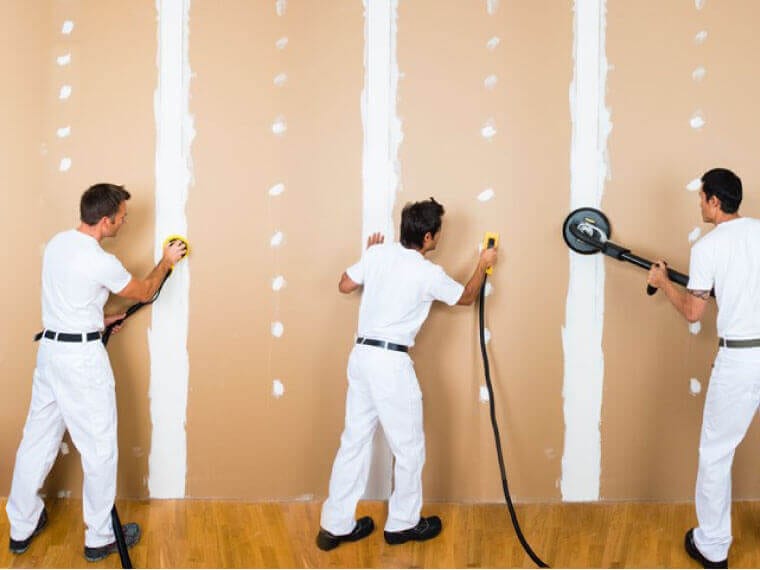Need Repair in The Great Vancouver Abbotsford Areas – Contact Us >
As a seasoned industry tradesman and highly skilled professional in Vancouver, I’ve witnessed the evolution of construction materials and techniques over the years. In this article, we will delve into the world of drywall repair and painting, specifically focusing on the cost considerations in Vancouver. Moreover, we will explore the comparisons between drywall and gypsum board, drywall and plasterboard, and examine some common questions like whether old drywall dust can make you sick, the potential for drywall mold, and whether drywall cracks with age. Lastly, we will explore the costs associated with replacing plaster with drywall and understand why plaster walls are no longer as prevalent as they once were.
Drywall Repair and Painting Costs in Vancouver
When it comes to drywall repair and painting in Vancouver, the cost can vary significantly depending on several factors. The size of the area that needs repair, the extent of the damage, and the quality of materials used all play a crucial role in determining the final price.
In general, the average cost of drywall repair in Vancouver ranges from $200 to $1,000, with painting costs on top of that. Smaller repairs, such as patching up small holes or cracks, are on the lower end of the spectrum, while larger projects involving extensive damage will naturally be more expensive.
For painting, the cost per square foot in Vancouver usually ranges from $1.50 to $4.00, depending on the complexity of the job and the quality of paint used. It’s important to note that these figures are approximate and can vary depending on the contractor you choose, your location within Vancouver, and the scope of the work.
Drywall vs. Gypsum Board vs. Plasterboard: A Comparative Analysis
Before diving into drywall repair, it’s essential to understand the materials involved. Drywall, gypsum board, and plasterboard are often used interchangeably, but they have distinct differences.
- Drywall: Drywall, also known as gypsum wallboard or sheetrock, is a widely used construction material. It consists of gypsum plaster sandwiched between two layers of paper. Drywall is relatively lightweight, easy to install, and cost-effective, making it a popular choice for residential and commercial projects.
- Gypsum Board: Gypsum board is essentially another term for drywall. Both refer to the same material, which is gypsum plaster encased in paper. The difference in terminology is more regional, with “gypsum board” being commonly used in some countries.
- Plasterboard: Plasterboard, on the other hand, typically refers to a board made from plaster that is applied in layers over a wooden or metal lath framework. It is a traditional construction material that predates drywall but is less commonly used today due to the labor-intensive installation process.
The choice between drywall and plasterboard often comes down to cost, ease of installation, and the specific requirements of the project. Drywall is favored for its affordability and speed of installation, while plasterboard is chosen for its durability and the classic look it provides.
Common Questions About Drywall
Now, let’s address some common questions about drywall:
- Can Old Drywall Dust Make You Sick?: Drywall dust can pose health risks if inhaled over an extended period. It may lead to respiratory issues, eye irritation, and skin problems. To prevent these risks, it’s crucial to wear proper protective gear and use dust containment measures during drywall work.
- Can Drywall Mold Live?: Yes, drywall can harbor mold if it becomes damp or experiences water damage. Mold can grow on the paper facing of drywall if moisture is present. Proper moisture control and prompt remediation of water damage are essential to prevent mold growth.
- Does Drywall Crack with Age?: Drywall can develop cracks over time due to settling of the building, temperature fluctuations, or structural movement. While small cracks are common and often cosmetic, significant cracks may indicate underlying issues and require professional attention.
Replacing Plaster with Drywall: Cost Considerations
One common project in older homes is the replacement of plaster walls with drywall. Plaster was once the standard for wall construction due to its durability and aesthetics, but it has largely been replaced by drywall for cost and efficiency reasons.
The cost of replacing plaster with drywall in Vancouver can vary widely depending on the size and complexity of the project. On average, you can expect to pay between $2,000 and $6,000 per room. Factors that influence the cost include the removal of old plaster, framing for drywall installation, drywall material and labor costs, and finishing (taping, mudding, and painting).
Why Don’t We Use Plaster Walls Anymore?
While plaster walls have a timeless charm and longevity, they are less commonly used today for several reasons:
- Cost: Plaster is more expensive and labor-intensive to install than drywall, making it less attractive for modern construction projects.
- Efficiency: Drywall can be installed more quickly than plaster, which is important in today’s fast-paced construction industry.
- Maintenance: Plaster is more prone to cracking, and repairing it can be more challenging and costly than repairing drywall.
- Materials: Drywall is readily available and standardized, whereas plaster requires more specialized materials and skilled labor.
Conclusion
In Vancouver, drywall repair and painting costs can vary depending on factors like the extent of damage and the size of the project. Understanding the differences between drywall, gypsum board, and plasterboard is crucial for making informed choices in construction or renovation projects. Moreover, addressing common concerns about drywall, such as health risks associated with old drywall dust and mold growth, is essential for ensuring a safe and healthy living environment.
For those considering replacing plaster with drywall, it’s important to budget for the project accordingly, as it can involve various costs, including demolition, framing, drywall installation, and finishing. Finally, while plaster walls still hold a special place in architectural history, the practicality, cost-efficiency, and ease of installation of drywall have made it the go-to choice for most contemporary construction projects.





